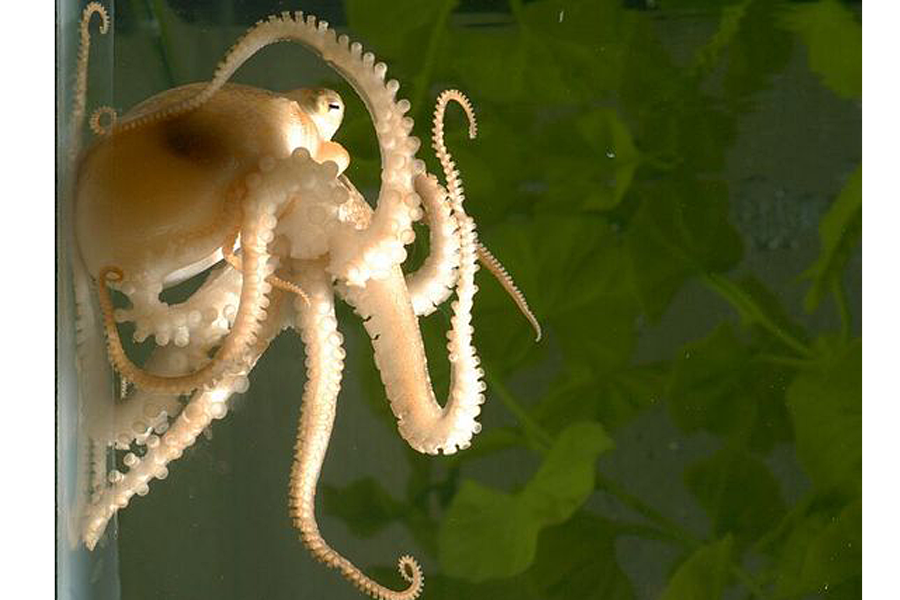Octopus genome reveals astonishing secrets
Loading...
Octopuses are known to be brainiacs — they can mimic flounder in a flash, unscrew themselves out of a sealed jar and even use coconut shells to build a mobile home. And now, for the first time, scientists have sequenced the genome of the eight-legged rock star, revealing how its complex noggin evolved.
Determining how octopuses' brains and bodies evolved "represents a first step to understanding these really cool animals at a new level," said Caroline Albertin, the lead researcher on the study and a graduate student studying evolution of animal development at the University of Chicago. "Having the genome represents having a tool kit that the animal draws on as it builds [its] really remarkable body and develops all these, really, very cool, behaviors," Albertin said.
Octopuses' clever behaviors are mirrored by their oddball nervous systems — not to mention their three hearts.
"The octopus nervous system is organized in a totally different way from ours: The central brain surrounds the esophagus, which is typical of invertebrates, but it also has groups of neurons in the arms that can work relatively autonomously, plus huge optic lobes involved in vision," study co-author Daniel Rokhsar, a professor of genetics and genomics at the University of California, Berkeley, said in a statement. "The sequencing was an opportunity to look at the genome and see what we can learn about the unique brain and morphology of the octopus."
With advanced technology — different from that used for the Human Genome Project, which was an international effort completed in 2003 to sequence human DNA and map all the genes of the species Homo sapiens — the researchers assembled and published the first genome of a cephalopod, the group that includes octopuses, squid and cuttlefish.
What makes an octopus an octopus
The researchers chose to sequence the genome of the California two-spot octopus (Octopus bimaculoides), a hearty octopus that is big, but small enough to live in an indoor aquarium, Albertin said. This octopus species produces "really gorgeous, transparent eggs that hatch and start behaving immediately like an octopus," Albertin told Live Science. [See Photos of the California Two-Spot Octopus]
Baby octopuses and adult octopuses can walk along the seafloor on their arms, using their sensitive suckers to feel out their way, and don't have to turn their bodies to change direction. One arm can push off a surface and thrust it where it needs to go.
This species has a lot of features that are common among cephalopods, such as cameralike eyes and body specializations like eight arms with hundreds of suckers on them, Yan Wang, a co-author of the study and a graduate student at the University of Chicago, told Live Science.
The researchers were surprised to find that the octopus genome looks a lot like that of any other mollusk (including clams and snails). Even so, there were some stark differences between the genomes of octopuses and those of other invertebrates, including an expansion of a group of genes linked to brain development and once thought to be unique to vertebrates.
The researchers also identified hundreds of cephalopod-specific genes that expressed specialized features of the octopus, including its slick, almost-transparent skin and many suckers. The researchers even think they've spotted the genes involved in adaptive coloration, in which an octopus can quickly alter its skin color and texture to blend in with its surroundings.
"We've found hundreds of novel genes that don't have counterparts in other animals and may be involved in this unique camouflage process," Rokhsar said in the statement.
Further analysis of the genome could reveal more octopus secrets, the researchers said. For instance, they hope to identify the genes responsible for the animals' ability to regenerate limbs, as well as those for the propulsion systems that let them jet around underwater and their prehensile arms that can feel and grasp. And what's responsible for the three hearts pumping blood across their gills?
The findings were published online yesterday (August 12) in the journal Nature.
Elizabeth Goldbaum is on Twitter. Follow Live Science @livescience, Facebook & Google+. Original article on Live Science.
- 8 Crazy Facts About Octopuses
- Cuttlefish Cuties: Photos of Color-Changing Cephalopods
- Clever Octopus Makes Like a Flounder
Copyright 2015 LiveScience, a Purch company. All rights reserved. This material may not be published, broadcast, rewritten or redistributed.





